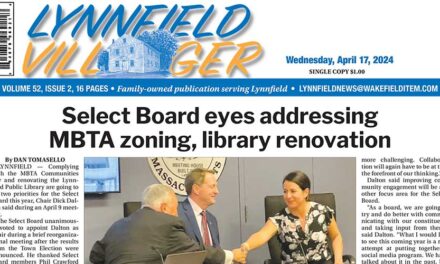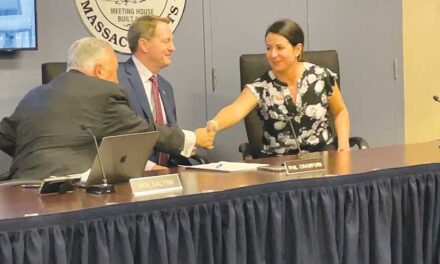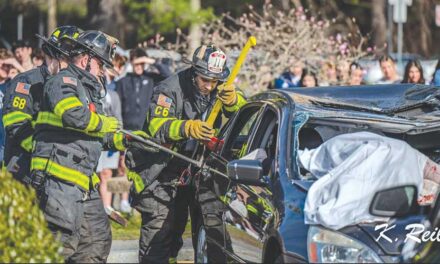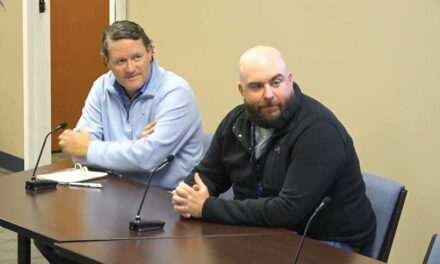Published in the June 20, 2018 edition
By DAN TOMASELLO
LYNNFIELD — Tensions ran high over proposed Summer Street roadway improvements during an informational meeting on June 12.
Bayside Engineering has been hired by the town to make improvements to Summer Street. The firm’s president, Norman Brown, said the town is looking to receive state and federal funds as part of a Massachusetts Department of Transportation (MassDOT) Transportation Improvement Plan (TIP) project.
Brown and Bayside representatives gave an overview of the project to 20 residents in attendance. He said improving the roadway and sidewalks would make them safer for pedestrians, bicyclists and wildlife.
While Brown said the project was originally scheduled to go from the Summer Street and Salem Street intersection to the historic district in the center of town, he said the proposed improvements would stop at Town Hall.
“The town thought we would need a lot more input on what if anything people want to see,” said Brown about the decision to scrap improvements to the historic district.
Senior Highway Engineer Michael Rizzo said three alternatives are being considered as part of the project.
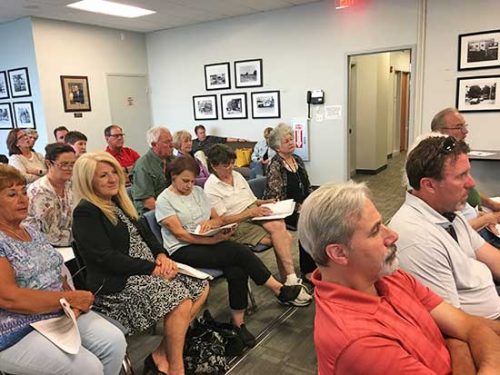
TWENTY RESIDENTS expressed their opposition to the proposed Summer Street road improvements project on June 12.(Dan Tomasello Photo)
“Back in 2014, the Massachusetts Department of Transportation developed the new healthy initiative,” said Rizzo. “The new healthy initiative included criteria that all shoulders must meet bicycle accommodations and that all shoulders must be five feet in width. The urban part of that classification tells us that the roadway needs to have sidewalks on both sides.”
Under Alternative 1, Rizzo said the 50-foot layout would have two 11-foot travel lanes, two five-foot shoulders on each side of the road to accommodate bicyclists and two five-and-a-half foot sidewalks on each side of the street.
Rizzo said Alternative 2 is slightly different, as a 10-foot wide shared use path would be built on one side of Summer Street in order to accommodate both pedestrians and bicyclists. He said Alternative 2 also includes the 50-foot layout, two 11-foot wide travel lanes and two 2-foot-wide shoulders. He said a three-foot-wide grass strip located between the shoulder and shared use path would be constructed as well.
Alternative 3 is similar to Alternative 2, Rizzo said. He said Alternative 3 would include two five-foot paved shoulders with vertical granite curbing, two 11-foot lanes, three-foot grass strip and a 10-foot bicycle lane.
“(The bicycle lane) would be great for the more active bicyclists who can remain in the road and travel at greater speeds, and would not have to travel in the 10-foot shared use path,” said Rizzo.
Rizzo said sidewalk improvements would be in compliance with the Americans with Disabilities Act.
Senior Civil and Environmental Engineer Bree Sullivan said the project would include constructing a drainage system and a stormwater management system. She also said the Pillings Pond culvert would be reconstructed as part of the project, which she said would have a positive impact on local wildlife particularly turtles.
Senior Project Engineer Bruno Campea said the project would improve the Summer Street at Walnut Street intersection and the Summer Street and Salem Street intersection.
While Rizzo doesn’t believe the project will require any land to be taken from abutters, he said temporary or permanent easements could be needed. He said the temporary easements could pertain to relocating utility poles, blending backs of sidewalks to front lawns, and constructing new driveway aprons.
“Every driveway would receive a new driveway apron,” said Rizzo. “The temporary easements will give the contractor the ability to enter onto (abutters’) property to do minor work. It doesn’t give them the right to store equipment. They are for the duration of the project, and at the end of the project, the temporary easements go away.”
Rizzo said permanent easements could be needed for sidewalk and utility pole maintenance.
Brown said once MassDOT’s Project Review Committee approves the project, he said the design process would begin.
“What that means is a survey crew would come out and spend a number of weeks locating poles, hydrants and curbs,” said Brown. “They might even go on your property for a little bit in case we have to blend in with loom. Once they put all that stuff together, they will create a base plan depending on which alternative (residents) would like to see. We will sit down with MassDOT and have a pre-submission meeting before we get too far ahead with the design to make sure we are going in the right direction.”
If the project moves forward, Brown anticipates it will take eight years to complete. He projects it will cost $15 million to make the roadway improvements to Summer Street.
Residents blast project
A number of residents who attended the public hearing expressed their opposition to the proposed Summer Street improvements project.
Theresa Yulling, 550 Summer St., claimed the information provided about wildlife deaths were exaggerated.
“The biggest problem is we have a speedway on Summer Street,” said Yulling. “If you widen Summer Street, you are asking for trouble. I suggest you fix the road and fix the sidewalk. Don’t try to construct everything on it. This is a town, not a city.”
Brown said “better defining” Summer Street’s lanes would “slow motorists down.”
Ian Claypool, 545 Summer St., said he’s concerned about people speeding on Summer Street.
“People are already using that road as a major thoroughfare,” said Claypool. “It’s a residential street. My daughter goes to school on that street. I would love it if the town would lower the speed limit. It says 35, but people are going 45 to 50 miles per hour. Whatever you do, don’t turn Summer Street into a highway because people already think it is.”
Gill Giugliano inquired if residents will have an opportunity to vote on the project.
“This sounds like a done deal,” said Giugliano. “We definitely need our streets fixed, but I think this should go to Town Meeting.”
“This is not a done deal,” said Brown.
Sullivan agreed.
“This is your project,” said Sullivan. “You have the ability to comment on this project through the planning stages. We want to bring you something that fits your community.”
Daventry Court resident Katy Shea asked why the Summer Street road improvement project is being considered instead of making improvements to the intersection at Salem Street and Route 1.
“I think that is a different animal,” said Brown. “I am pretty sure both of those are state highways. The state controls that, so a municipality wouldn’t spend any money to design a project for a state roadway and state highway. That is up to the state to do. This is an opportunity for (the town) to maintain Summer Street. For 10 to 15 cents on the dollar, this is an opportunity for the state to come in and do the project. This project looks to cost about $15 million dollars in state funding.”
Gary Scarborough, 736 Summer St., claimed the project would relocate a utility pole “at least eight feet closer to my house.”
“That to me is an extreme easement intrusion,” said Scarborough. “That is one thing that bothers me tremendously. Fix the sidewalks and remove the trees in the middle of the sidewalks. Cut them down, clean them up and put in the ADA compliant sidewalks in if that is what it takes to get the state and federal funding. Paint the lines and pave the road. Fix what is there so people can use it. They don’t need a dedicated path.”
Rizzo said, “The existing roadway width is about 30 feet.”
“The proposed roadway cross section for the pavement is 32 feet,” said Rizzo. “It’s not going to change much at all. And with the sidewalk up against the curb, the poles will be right up against the sidewalk. No poles are going to be moved back eight to 10 feet. A utility pole might have to be moved 12 inches.”
John Ricciardone, 618 Summer St., said the town has “done a pretty poor job maintaining stuff.”
“By doing this, it will increase speed,” said Ricciardone. “It seems like we are doing a lot for bikes and turtles. If the bike path goes through, how many bike things do we need in this town? A shared lane with bicyclists and pedestrians is going to be a disaster.”
Ricciardone also expressed concerns that the project would destroy the canopy along Summer Street because trees would need to be cut down. DPW Director John Tomasz vowed to limit the number of trees that would be felled.
Brown said the bicycle accommodations have been incorporated into the proposed plans in order to receive state money.
In response to a question from Giugliano, Tomasz said the DPW gets about $1 million annually for road repairs. He said the town allocates $500,000 for road repairs and the town receives about $500,000 in Chapter 90 funds.
“The town is very generous,” said Tomasz. “With that $1 million, we are able to do about 10 streets per year. We have an opportunity to do a major street, and the state and federal government (are) willing to pick up 85 to 90 percent of the tab. I wouldn’t be doing my duty if I didn’t just investigate and find out what opportunities are there for us, whether they are good or bad. This is not a one or two year process. This is at least seven years down the road.”
In response to a question from Yulling, Tomasz said the town is pursuing state funds for the Summer Street project in order to save money.
“For us to do it in-house, it would be $10 million dollars,” said Tomasz. “That’s 10 years that 70 streets won’t get done because we would have to focus all of our money on Summer Street. If I did that, I would hear a lot about it. That is why we have done Lowell Street and Chestnut Street in sections. We are trying to be fair.”

